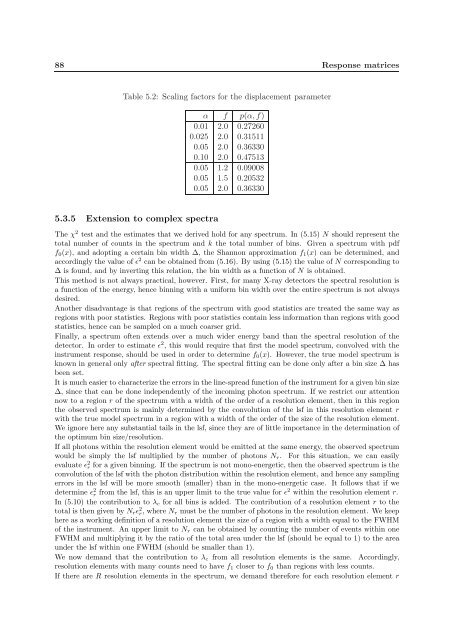SPEX User's Manual - SRON
SPEX User's Manual - SRON
SPEX User's Manual - SRON
You also want an ePaper? Increase the reach of your titles
YUMPU automatically turns print PDFs into web optimized ePapers that Google loves.
88 Response matrices<br />
Table 5.2: Scaling factors for the displacement parameter<br />
α f p(α,f)<br />
0.01 2.0 0.27260<br />
0.025 2.0 0.31511<br />
0.05 2.0 0.36330<br />
0.10 2.0 0.47513<br />
0.05 1.2 0.09008<br />
0.05 1.5 0.20532<br />
0.05 2.0 0.36330<br />
5.3.5 Extension to complex spectra<br />
The χ 2 test and the estimates that we derived hold for any spectrum. In (5.15) N should represent the<br />
total number of counts in the spectrum and k the total number of bins. Given a spectrum with pdf<br />
f 0 (x), and adopting a certain bin width ∆, the Shannon approximation f 1 (x) can be determined, and<br />
accordingly the value of ǫ 2 can be obtained from (5.16). By using (5.15) the value of N corresponding to<br />
∆ is found, and by inverting this relation, the bin width as a function of N is obtained.<br />
This method is not always practical, however. First, for many X-ray detectors the spectral resolution is<br />
a function of the energy, hence binning with a uniform bin width over the entire spectrum is not always<br />
desired.<br />
Another disadvantage is that regions of the spectrum with good statistics are treated the same way as<br />
regions with poor statistics. Regions with poor statistics contain less information than regions with good<br />
statistics, hence can be sampled on a much coarser grid.<br />
Finally, a spectrum often extends over a much wider energy band than the spectral resolution of the<br />
detector. In order to estimate ǫ 2 , this would require that first the model spectrum, convolved with the<br />
instrument response, should be used in order to determine f 0 (x). However, the true model spectrum is<br />
known in general only after spectral fitting. The spectral fitting can be done only after a bin size ∆ has<br />
been set.<br />
It is much easier to characterize the errors in the line-spread function of the instrument for a given bin size<br />
∆, since that can be done independently of the incoming photon spectrum. If we restrict our attention<br />
now to a region r of the spectrum with a width of the order of a resolution element, then in this region<br />
the observed spectrum is mainly determined by the convolution of the lsf in this resolution element r<br />
with the true model spectrum in a region with a width of the order of the size of the resolution element.<br />
We ignore here any substantial tails in the lsf, since they are of little importance in the determination of<br />
the optimum bin size/resolution.<br />
If all photons within the resolution element would be emitted at the same energy, the observed spectrum<br />
would be simply the lsf multiplied by the number of photons N r . For this situation, we can easily<br />
evaluate ǫ 2 r for a given binning. If the spectrum is not mono-energetic, then the observed spectrum is the<br />
convolution of the lsf with the photon distribution within the resolution element, and hence any sampling<br />
errors in the lsf will be more smooth (smaller) than in the mono-energetic case. It follows that if we<br />
determine ǫ 2 r from the lsf, this is an upper limit to the true value for ǫ 2 within the resolution element r.<br />
In (5.10) the contribution to λ c for all bins is added. The contribution of a resolution element r to the<br />
total is then given by N r ǫ 2 r , where N r must be the number of photons in the resolution element. We keep<br />
here as a working definition of a resolution element the size of a region with a width equal to the FWHM<br />
of the instrument. An upper limit to N r can be obtained by counting the number of events within one<br />
FWHM and multiplying it by the ratio of the total area under the lsf (should be equal to 1) to the area<br />
under the lsf within one FWHM (should be smaller than 1).<br />
We now demand that the contribution to λ c from all resolution elements is the same. Accordingly,<br />
resolution elements with many counts need to have f 1 closer to f 0 than regions with less counts.<br />
If there are R resolution elements in the spectrum, we demand therefore for each resolution element r

















